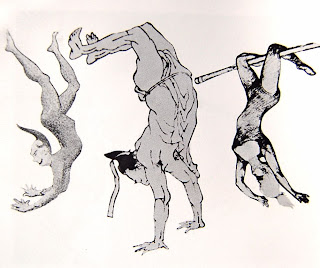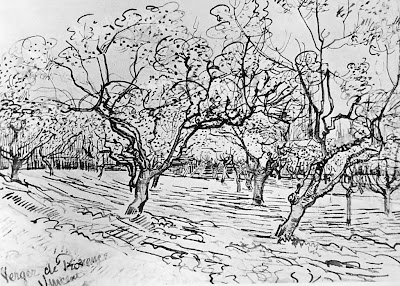Japonisme
Part 1
Edgar Degas - The Bath (1886)
If you have been following this blog in recent months you will have seen how I have been looking at the impact Japanese art at the turn of the 20th century had on great Modernists painters, including Degas and Monet.
This time I want to look at the work of Toulouse Lautrec
Of the three great painters under discussion, Lautrec is perhaps the one who most readily absorbed the impact Japanese art made on French artists after 1858
Let's start with what he is perhaps best known for - his posters
Undoubtedly, Lautrec was a hugely innovative artist whose style, immediately recognisable then as now, seems to be the product of innate genius
That is only partly true!
Like many other major artists of this period, Lautrec was exposed to an influx of Japanese art, especially coloured woodcuts and prints
Katsushika Hokusai 1814-78
What Lautrec recognised immediately was the absolute freedom with which these Japanese artists drew their figures - revealing an entirely new (to French art, at least) repertoire of intimate, spontaneous actions and postures from everyday life
At this time Lautrec deliberately immersed himself in the demi-monde of Momartre, largely to escape the constraints of polite, bourgeois Parisian life
This, together with new forms of expressiveness derived from Japanese art, transformed his graphic work
There is a ebullience to these drawings but in each case the actual forms are inspired by Japanese precedents directly applied to the circus acrobats or dancers he loved to draw
The figure in the middle of the illustration below is by Hokusai. The acrobat on the left is by Seurat and the one on the right by Lautrec
He took from these woodcuts not only new gestures but also ways of expressing, in graphic form, human emotion. The figure on the right (below) is by Toshusai Sharaku (1794)
In so doing Lautrec acquired a remarkable economy of line, clearly evident - for example - in his early studies for his poster featuring the singer Aristide Bruant. The figure on the left (below) is by Katsukawa Shunko (1784)
This resulted in one of Lautrec's most celebrated posters, first printed in 1893
This influence extended also into his non-commercial work - his paintings and crayon drawings of the prostitutes and dancers he befriended at the Moulin Rouge
These works are amongst his finest, remarkable for both their expressiveness and the freedom with which they are executed
This wonderful crayon study of the dancer Jane Avril reveals Lautrec's stunning technique. The spontaneity of his line and the brave use of colour - particularly the reds in this example - are astonishing
Even though he had clearly mastered Japanese graphic techniques Lautrec still drew on Japanese art for new compositions - like this detail (above) from his poster Reine de joie of 1892
Isoda Koryusai (1775)
The result again is a graphic design that is economical, bold but hugely expressive:
It is clear by now, I hope, that Toulouse Lautrec was greatly influenced by Japanese art at the end of the 19th Century - as were many other major French artists
Although I suspect that this photograph of Lautrec in Japanese costume is very 'tongue-in-cheek' there is no denying the profound influence Japanese art had on his development as an artist
That, combined with his natural genius, produced some of the most expressive works in the history of modern art
JAPONISME
Part 2
Earlier I looked at the impact Japanese art had on the work of Lautrec.
Part 2
Earlier I looked at the impact Japanese art had on the work of Lautrec.
This week I would like to look at the art of Vincent Van Gogh in that context
Those
of us who admire Van Gogh's work would assume, not unreasonably, that
the above painting was the unique creation of a singular genius
We would be wrong!
Van Gogh, like other great artists of his period, was profoundly influenced by Japanese art flooding into Europe after 1858
Japanese
art not only opened up entirely new subject areas for Western
practitioners but introduced new techniques which artists like Van Gogh,
Lautrec and, later, the creators of Art Nouveau readily embraced
Both
Vincent Van Gogh and his brother Theo (then an art dealer working in
London) had access to literally hundreds of prints from Japan
Van Gogh greedily absorbed both the forms and colours of the work of Hokusai, Kuniyoshi, Utamaro and other Japanese masters - to the extent that he began to see Arles (where he now lived) as a Japanese landscape in itself!
Van Gogh greedily absorbed both the forms and colours of the work of Hokusai, Kuniyoshi, Utamaro and other Japanese masters - to the extent that he began to see Arles (where he now lived) as a Japanese landscape in itself!
"For my part", he wrote, "
I don't need Japanese pictures here, for I am always telling myself
that here I am in Japan. Which means I have only to open my eyes and
paint what is right in front of me, if I think it effective".
He began his absorption of Japanese art by faithfully copying works (mostly colour prints/woodcuts) that he came across
This was not just a matter of shape and construction but colour. The colours we associate with Van Gogh in Arles are not necessarily, therefore, the colours of Provence but something uniquely Japanese
Similarly,
the way Van Gogh now used his brush was entirely derived from the 'line
and dot' technique traditionally used by Japanese artists. These
techniques, themselves derived from earlier traditions in China, were
entirely new to the West
For
example, Van Gogh experimented in both landscape and tree forms,
copying the Japanese masters while at the same time closely observing
the flora and fauna of the countryside around the town of Arles
This
is evident in the series of tree forms he painted, using the
traditional Japanese brush which he also mastered. The examples given
here are made with a Japanese reed pen
What Van Gogh also grasped was the Oriental notion that the essence of a tree or plant was not necessarily its external form but some kind of conceptual notion of 'tree' or 'plant'
To be 'true' to that aspect was more important than mere verisimilitude
To be 'true' to that aspect was more important than mere verisimilitude
These
- and other related studies from the Japanese masters - radically
transformed the art of Vincent Van Gogh and, inevitably, our own
notions of what constitutes beauty and expressiveness in Western art
It is worth adding, perhaps, that these borrowings do not diminish Van Gogh's status as an artist. It takes a genius to accomodate new techniques so effectively and to create works that retain one's 'signature' so effecively
It is worth adding, perhaps, that these borrowings do not diminish Van Gogh's status as an artist. It takes a genius to accomodate new techniques so effectively and to create works that retain one's 'signature' so effecively
Footnote
The illustrations for this article are taken from Japonsisme by Siegfried Wichmann, published by Thames and Hudson (1981)
To look at the wide range of art books published by Thames and Hudson, click on the link below:


























No comments:
Post a Comment